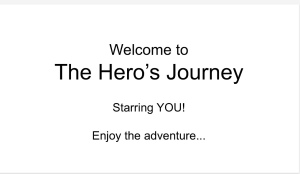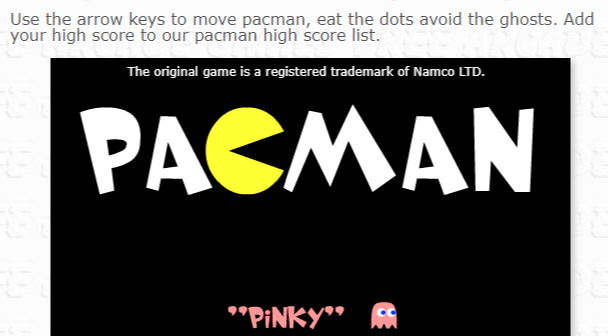Tagged: Education
(App)Smashing Test Prep: 2-Minute Tutorial Videos
While exploring the pattern of the hero’s journey in literature, my juniors partake in their own learning journey through literacy and life. To experience the structure of Joseph Campbell’s monomyth, I organize my World Literature and Composition course according to four major stages of the hero’s journey.
- Separation from the Ordinary World
- Initiation: The Trials and Challenges of Heroism
- Transformation: An Inward Journey
- The Return

After they accept the call to adventure, juniors cross the threshold into an unknown world of trials and challenges during quarter two. As we study the adventures of heroes through selected epics, I am responsible for guiding student progress and training for greater tests of skill.
My young heroes have to build strength, endurance, and stamina to perform admirably. They need to become critical thinkers, careful readers, and confident writers. But without the assistance of divine intervention or supernatural aid, I simply want to give my students the advantage of understanding their human flaws and feeling secure in their abilities. A seemingly daunting ACT/SAT exam is nothing more than a one-day opportunity to allow for easier passage to the next stage of their journey (and can be retaken). It is not a predictor of future success or self-worth.
This year, learners are attacking their training and preparation for battle. So what’s making the difference? My courageous juniors are not only exercising their minds; they are expressing their voices. Continue reading
Discovering New Superheroes: Learner Backstories
Despite their flaws and all-too-human struggles, my students become my heroes in the journey we share. This school year, like any other, is off to a great start in World Literature and Composition—a course I am teaching for the 20th year. After a summer of reflection and planning for the new year, I have made several changes that I am excited to put in writing.
This September, juniors were greeted by the following message and introduction.

Consistent with past years, the course is structured thematically within the framework of the hero’s journey. Each quarter focuses on a major stage of the journey, full of learning adventures, personal quests, and literary study.
In order to personalize learning in this class we traditionally spend time identifying who we are in our Ordinary World before crossing the threshold into an unknown world of trials and challenges. I ask new classes to reflect on their interests, learner strengths and struggles, learning preferences, and future plans as a means of getting to know my students and to help them develop a personalized learner profile (PLP).
The improvement to this year’s approach was simple, but the response was significant. I challenged learners to re-create themselves as superheroes. Without hesitation, fifty high school juniors accepted the Call to Adventure and have since been fully engaged in their design process. Continue reading
The Path to Humanity
In preparation for the annual study of Elie Wiesel’s Night, freshmen are introduced to the United Nations’ Universal Declaration of Human Rights. Many are unaware of the document’s existence. When they explore the United Nations’ website, they initially consider the thirty articles common sense. Then, with general awareness of current events and simple research of news headlines, they recognize blatant violations of such rights around the world. After careful consideration, my students identify conflicting messages within and interpretations of the human rights on the list.
My students react with compassion. From a safe distance, a global concern becomes a topic worth exploring—something to address in a research paper or presentation—much like a history lesson. The natural human response to social injustice is sympathy—feelings of pity and sorrow for others’ misfortune. My freshmen acknowledge progress begins with education. Knowledge builds understanding. Understanding creates perspective. The more they learn and process about the world, the more they recognize issues closer to home. The lessons are internalized—the experiences personal. At this point, fifteen-year-olds open their eyes and hearts to their surroundings. The time has come for the adult in the classroom to step aside and proudly observe what evolves. Continue reading
The Pac-Man Model of School

Ready! Chomp – chomp – chomp – ch – ch – ch – chomp. Eat the dots. Avoid the ghosts. Clear the screen. Repeat.
How many hours did children of the ‘80s invest in Pac-Man marathons, navigating that maze, staring at the same straightaways and right angles? Enough to create repeatable patterns to clear each screen with nearly mindless precision. Yes, the game required some strategy and skill; however, once players understood the concept, game play was reduced to a matter of accumulating as many points as possible by eating dots in a maze before running out of lives.

Got some time to kill? Play a round of Flash Pac-Man on-line.
Old School Design
Pac-Man is a classic video game—as old school as it gets. However, while fans of retro video games still exist, many of our young gamers are not attracted to the simple graphics and redundant concept. With more appealing options available (such as Call of Duty games) to this generation of gamers, Pac-Man fails to maintain their attention long enough to keep them engaged. As video game systems continue to be part of our everyday lives, improved models have evolved to meet the standards of emerging technology and consumer demands. The most popular games present stimulating challenges, authentic experiences (multiplayer options, online gaming, first person views), multiple options to explore, real-time feedback, ability to save progress, and fast-paced action.
Toru Iwatani designed the game to have no ending, as long as the player had at least one life remaining. Only the gifted arcade all-stars would see the game through all 255 screens. Sounds frustrating to the common gamer; yet, we continued to insert the cartridge into the Atari 2600, reset the game, and play again.
The Pac-Man Model
It’s no wonder, in the Pac-Man model of school, students feel trapped in a maze, facing the same routine everyday. The bell signals the start of another day. Down one hallway. Turn left. Then right. Hesitate. Look around for a moment. Resume.
Even during his strongest moments, Pac-Man is a consumer, not a creator. Times of empowerment are limited. The best players take advantage of each power pellet. They make significant progress toward their destination in a short amount of time. However, the further they advance, the more the game seems to speed up. The ghosts get quicker and return to the chase almost immediately. After chomping one ghost (surviving a quiz?), Pac-Man knows he will be challenged by a similar test again.
Do we ask more from our students? Not according to the Pac-Man model of school. Continue reading
A Reflective Approach to Personalize Learning
Leading change. Launching new initiatives. Driving improvement. Shifting a mindset. These phrases inspire some to turn visions into purposeful actions, but leave others with frustration and trepidation. Typically, leaders present ideas, committees are formed, and agendas are set. Responses are mixed—investment levels varied—but we move forward in education.
We’ve identified our purpose. We will reach every student, every day to prepare learners for success in a dynamic world, as advertised in school mission statements. But at the end of a typical (chaotic) school day, can we claim success in achieving our goal? There’s no perfect solution that packages a best practice script, complete with a how-to manual and answer key. However, with the help of educators sharing their experiences and effective models, we can shift a cultural mindset toward personalized learning. Personalized learning is not a program nor a new initiative; it is a philosophy.
The process of where to begin may appear hazy, but our efforts are validated by a clear purpose—reinforced by several simple educator truths.
- We care about our students.
- We want all students to learn.
- We are passionate about education.
- We take pride in our professional roles.
- We impact lives.
- We can always improve our craft.
The last truth often gets misinterpreted as a deficiency—a professional flaw or incompetence—but this is certainly not the case. As the world evolves, so must education. For educators, this means finding new ways to engage, challenge, and empower our learners. While we acknowledge the importance of placing students at the center of learning, many teachers continue to lead from the front of the classroom. Breaking the expected norms of what it means to teach (especially when being evaluated) is daunting. Before diving in or battling with logistics, educators should approach their entry point based on individual understanding and readiness. For educators seeking to personalize their classes:
- Know where you’re at
- Think big but start small
- Design backwards to move forward
Professional growth begins with reflection
When we reflect on our current practices, we may find personalized learning is not far beyond our reach. I invite educators to utilize the reflection guide to increase understanding of personalized learning and recognize how many components of the personalized learning model they already implement. Continue reading


